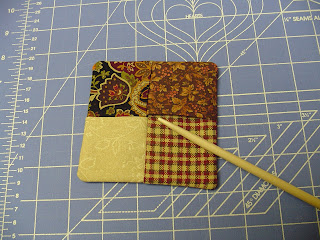
Ok, having struggled with fabric choices in the past, I thought I'd like to get a design wall too but the cost was prohibitive. Some of them went as high at $300-$400. Wa-a-ay out of this girl's budget. Another popular method was to make one from foam insulation board, covering it in flannel or fleece. That took up more room than I wanted so I made one using 1-1/8 yard fleece (only because that was what was left on the bolt at the store so they gave it to me at a discount), a cafe rod, and a pair of command strip hooks. All told I think I have about $10 invested in this.
I washed the fleece and cut the sides even then sewed a casing at the top for the cafe rod. The hardest part was positioning the command strip hooks to hang the cafe rod (I'm vertically challenged).
Mine is probably a little smaller than the average design wall but I don't really have the room for anything too big. For me, this works great. The blocks cling to the fleece without pins and as you can see from the picture, I have room for multiple projects. (The bottom row is for a Christmas table runner and the top two rows are the blocks from quilting class.) Best of all this is totally portable so I can roll it up and take it with me or take it down and put it in the closet when not needed.
Have to keep it real here and say that some of my recent projects haven't been exactly perfect, for example, the photo album cover I did today...I put the ric rac on crooked. (Hey, I had a casserole in the oven and a hungry hubby wanting his lunch so I was a little distracted!) But the design wall was one project that turned out exactly as planned!





























